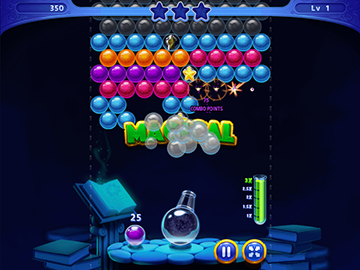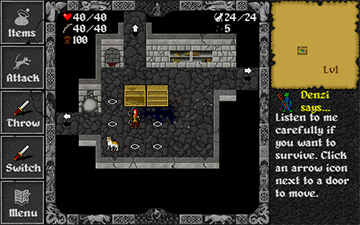22 KiB
Phaser

Phaser is a fast, free and fun open source HTML5 game framework. It uses Pixi.js for WebGL and Canvas rendering across desktop and mobile web browsers. Games can be compiled to iOS and Android apps via 3rd party tools.
Along with the fantastic open source community Phaser is actively developed and maintained by Photon Storm Limited. As a result of rapid support and a developer friendly API Phaser is currently one of the most starred game frameworks on Github.
Thousands of developers worldwide use it. From indies and multi-national digital agencies to schools and Universities. Each creating their own incredible games. Grab the source and join in the fun!
- Visit: The Phaser website and follow on Twitter (#phaserjs)
- Learn: API Documentation, Support Forum and StackOverflow
- Code: 550+ Source Examples (also available in this git repo)
- Read: Subscribe to the Newsletter and grab our Phaser Books
- Chat: #phaserio IRC channel on freenode
- Extend: With Phaser Plugins
- Be awesome: Support the future of Phaser on Patreon or by buying our books and plugins
Index
- What's New?
- Support Phaser
- Download Phaser
- Getting Started
- Using Phaser
- Games made with Phaser
- Requirements
- Road Map
- Change Log
- Contributing
What's new in Phaser 2.4.4

24th August 2015
The release of Phaser 2.4.4 continues our work with bug fixes, new features and continued optimizations. As before it's a point-release, making it a safe upgrade for anyone using a previous 2.4 build.
As well as working on this release we've also been busily writing tutorials for the first issue of Interphase, our new publication for Phaser developers. Packed full of exclusive content we've been coding games, writing tutorials and authoring deep-dive articles for the first issue. It's been a blast so far and I'm excited for it's release in early September - and if you pre-order now with the discount code 'earlybird' you can save 15% on the cover price.
Finally we'd be extremely grateful if you could get involved with our Phaser Patreon campaign. The uptake so far has been fantastic. Thank you to everyone who now supports Phaser development and shares our belief in the future of HTML5 gaming and Phasers role in that.
Happy coding everyone! See you on the forums.
Cheers,
Rich - @photonstorm
Support Phaser on Patreon
Please help support the future development of Phaser through our Patreon campaign. We've some exciting plans and there's so much we'd like to do. Let's see if we can all work together to make this possible.
Phaser Sponsors
Phaser is sponsored by the following great companies:
QICI Engine: A powerful one-stop integrated Phaser game editor
Zenva Academy: Online courses on Phaser, HTML5 and native app development
Download Phaser
Phaser is hosted on Github. There are a number of ways to download it:
- Clone the git repository via https, ssh or with the Github Windows or Mac clients.
- Download as zip or tar.gz
- Download just the build files: phaser.js and phaser.min.js
- Checkout with svn
Bower / npm
Install via bower
bower install phaser
Install via npm
npm install phaser
CDN
jsDelivr is a "super-fast CDN for developers". Include the following in your html:
<script src="//cdn.jsdelivr.net/phaser/2.4.4/phaser.js"></script>
or the minified version:
<script src="//cdn.jsdelivr.net/phaser/2.4.4/phaser.min.js"></script>
cdnjs.com also offers a free CDN service. They have all versions of Phaser and even the custom builds:
<script src="https://cdnjs.cloudflare.com/ajax/libs/phaser/2.4.4/phaser.js"></script>
Phaser Sandbox
If you'd like to try coding in Phaser right now, with nothing more than your web browser then you can head over to the Phaser Sandbox. You'll find Quick Start templates and a user-friendly editor filled with handy code-completion features.
Koding
Want to try Phaser without downloading anything? The site Koding offer a complete browser-based virtual machine to work in, allowing you to clone the Phaser repo and start work immediately.
License
Phaser is released under the MIT License.
Getting Started

We have a Getting Started Guide which covers all you need to begin developing games with Phaser. From setting up a web server, to picking an IDE and coding your first game.
Prefer videos to reading? Lynda.com have published a free course: HTML5 Game Development with Phaser
The single biggest Phaser resource is the new Phaser web site. It has hundreds of tutorials listed and fresh ones are added every week, so keep coming back to see what's new!
Using Phaser with TypeScript? Check out this great series of Game From Scratch tutorials.
Source Code Examples
Ever since we started Phaser we've been growing and expanding our extensive set of source code examples. Currently there are over 500 of them!
Browse the Phaser Examples or clone the examples repo and eat your heart out!
Phaser Books

We've been busy writing books about Phaser. Available now:
- A Guide to the Phaser Tween Manager Book + Code Bundle
- A Guide to the Phaser Scale Manager
With more on the way. Vote on the next title to be written.
Game Mechanic Explorer
The Game Mechanic Explorer is a great interactive way to learn how to develop specific game mechanics in Phaser. Well worth exploring once you've got your dev environment set-up.
Mighty Editor - Visual Game Editor
MightyEditor is a browser-based visual Phaser game editor. Create your maps with ease, position objects and share them in seconds. It also exports to native Phaser code. Excellent for quickly setting-up levels and scenes.
Using Phaser
Phaser is provided ready compiled in the build folder of the repository. There are both plain and minified versions. The plain version is for use during development and the minified version for production.
Custom Builds
Starting from Phaser 2.3.0 we now include a brand new build system which allows you to strip out lots of additional features you may not require, saving hundreds of KB in the process. Don't use any Sound in your game? Then you can now exclude the entire sound system. Don't need Keyboard support? That can be stripped out too.
As a result of this work the minimum build size of Phaser is now just 80KB minified and gzipped.
See the Creating a Custom Phaser Build tutorial for details.
Building from source
Should you wish to build Phaser from source you can take advantage of the provided Grunt scripts. Ensure you have the required packages by running npm install first.
Run grunt to perform a default build to the dist folder.
Games made with Phaser
Thousands of games have been made in Phaser. From game jam entries to titles by some of the largest entertainment brands in the world. Here is a tiny sample:
Artwork copyright their respective owners.
We add new games to the Phaser site weekly, so be sure to send us yours when it's finished!
Requirements
Phaser requires a web browser that supports the canvas tag. This includes Internet Explorer 9+, Firefox, Chrome, Safari and Opera on desktop. iOS Safari, Android Browser and Chrome for Android are supported on mobile.
While Phaser does its best to ensure a consistent cross-platform experience always be aware of browser and device limitations. This is especially important with regard to memory and GPU limitations on mobile, and legacy browser HTML5 compatibility.
IE9
If you need to support IE9 / Android 2.x and use P2 physics then you must use the polyfill in the resources/IE9 Polyfill folder. If you don't use P2 (or don't care about IE9!) you can skip this.
JavaScript and TypeScript
Phaser is developed in JavaScript. We've made no assumptions about how you like to code and were careful not to impose a strict structure upon you. You won't find Phaser split into modules, requiring a build step, or making you use a class / inheritance OOP approach. That doesn't mean you can't do so, it just means we don't force you to. It's your choice.
If you code with TypeScript there are comprehensive definition files in the typescript folder. They are for TypeScript 1.4+.
Road Map
All Phaser development is now taking place on the Phaser 3 project. The Phaser 2 branch will still be supported and issues fixed, but roadmap features have been migrated over to Phaser 3.
Phaser 3
We're now a good way in to development of Phaser 3. We've been working hard on creating a brand new and extremely powerful renderer. Progress reports are posted to the web site and Phaser 3 repo.
There is still plenty of time to add your suggestions and feedback in this forum thread.
If you are an exceptional JavaScript developer and would like to join the Phaser 3 development team then let us know. We have a limited budget available to pay towards your time.
Change Log
Version 2.4.4 - "Amador" - in dev
New Features
- Emitter.emitParticle now has 4 new optional arguments:
x,y,keyandframe. These allow you to override whatever the Emitter default values may be and emit the particle from the given coordinates and with a new texture. - Group.resetChild is a new method that allows you to call both
child.resetand/orchild.loadTextureon the given child object. This is used internally bygetFirstDeadand similar, but is made public so you can use it as a group iteration callback. Note that the child must have publicresetandloadTexturemethods to be valid for the call. - Group.getFirstDead, Group.getFirstAlive and Group.getFirstExists all have new optional arguments:
createIfNull,x,y,keyandframe. If the method you call cannot find a matching child (i.e. getFirstDead cannot find any dead children) then the optionalcreateIfNullallows you to instantly create a new child in the group using the position and texture arguments to do so. This allows you to always get a child back from the Group and remove the need to do null checks and Group inserts from your game code. The same arguments can also be used in a different way: ifcreateIfNullis false AND you provide the extra arguments AND a child is found then it will be passed to the newGroup.resetChildmethod. This allows you to retrieve a child from the Group and have it reset and instantly ready for use in your game without any extra code. - P2.Body.removeCollisionGroup allows you to remove the given CollisionGroup, or array of CollisionGroups, from the list of groups that a body will collide with and updates the collision masks (thanks @Garbanas #2047)
- Filter.addToWorld allows you to quickly create a Phaser.Image object at the given position and size, with the Filter ready applied to it. This can eliminate lots of duplicate code.
- Tiled 0.13.0 added support for layer data compression when exporting as JSON. This means that any .tmx stored using base64 encoding will start exporting layer data as a base64 encoded string rather than a native array. This update adds in automatic support for this as long as the data isn't compressed. For IE9 support you'll need to use the new polyfill found in the resources folder (thanks @noidexe #2084)
- You can now load single layer Pyxel Edit TileMaps as an atlas (thanks @joshpmcghee #2050)
- Canvas.getSmoothingPrefix will return the vendor prefixed smoothing enabled value from the context if set, otherwise null.
Updates
- TypeScript definitions fixes and updates (thanks @clark-stevenson @milkey-mouse @timotei @qdrj @Garbanas @cloakedninjas)
- Docs typo fixes (thanks @rwrountree @yeluoqiuzhi @pnstickne @fonsecas72)
- Math.average has been optimized (thanks @rwrountree #2025)
- When calling GameObject.revive the
healmethod is called to apply the health value, allowing it to take into consideration amaxHealthvalue if set (thanks @bsparks #2027) - Change splice.call(arguments, ..) to use slice instead (thanks @pnstickne #2034 #2032)
- BitmapData.move, moveH and moveV have a new optional
wrapargument allowing you to control if the contents of the BitmapData are wrapped around the edges (true) or simply scrolled off (false). - Time.desiredFps has moved to a getter / setter.
- Time.physicsElapsed and Time.physicsElapsedMS are no longer calculated every frame, but only when the desiredFps is changed.
- Time.update has been streamlined and the
updateSetTimeoutandupdateRAFmethods merged and duplicate code removed. - Time.desiredFpsMult is a pre-calculated multiplier used in Game.update.
- Time.refresh updates the
Time.timeandTime.elapsedMSvalues and is called automatically by Game.update. - DeviceButton was setting a
durationproperty on itself, which went against the read only getter of duration (thanks @winstonwolff) - Added Node.js v4 stable to Travis config (thanks @phillipalexander #2070)
- Optimised Canvas.getSmoothingEnabled, Canvas.setSmoothingEnabled and Canvas.setImageRenderingCrisp.
Bug Fixes
- Loader.bitmapFont wouldn't automatically set the
atlasURLvalue if just the key was given. - The Loader would put the baseURL and/or path in front of
data:andblobURLs (thanks @rblopes #2044) - When the Text width was being calculated it would add the
strokeThicknessvalue twice, causing an alignment offset (thanks @nickryall #2039) - Sound.onEndedHandler has a fix for AudioBufferSourceNode listener memory leak (thanks @Pappa #2069)
- Game.update could call
updateLogicmultiple times in a single frame when catching up with slow device frame rates. This would cause Tweens to advance at twice the speed they should have done (thanks @mkristo) - Added useCapture flags to removeEventListener in MSPointer class (thanks @pmcmonagle #2055)
- Under setTimeOut (or when
forceSetTimeOutwas true) the Time was incorrectly settingTime.timeExpectedcausing game updates to lag (thanks @satan6 #2087)
Pixi Updates
- CanvasRenderer.mapBlendModes optimised to cut down on file size.
For changes in previous releases please see the extensive Version History.
Contributing
Please read the Contributors Guide for full details on helping with Phaser, but the main points are:
-
Found a bug? Report it on GitHub Issues and include a code sample.
-
Pull Requests should only be made against the
devbranch. Never againstmaster. -
Before submitting a Pull Request run your code through JSHint using our config.
-
Before contributing please read the code of conduct.
Written something cool that shows Phaser in use? Please tell us about it in our forum or email: support@phaser.io
Phaser is a Photon Storm production.
Created by Richard Davey. Powered by coffee, anime, pixels and love.
The Phaser logo and characters are © 2015 Photon Storm Limited.
All rights reserved.
"Above all, video games are meant to be just one thing: fun. Fun for everyone." - Satoru Iwata

























